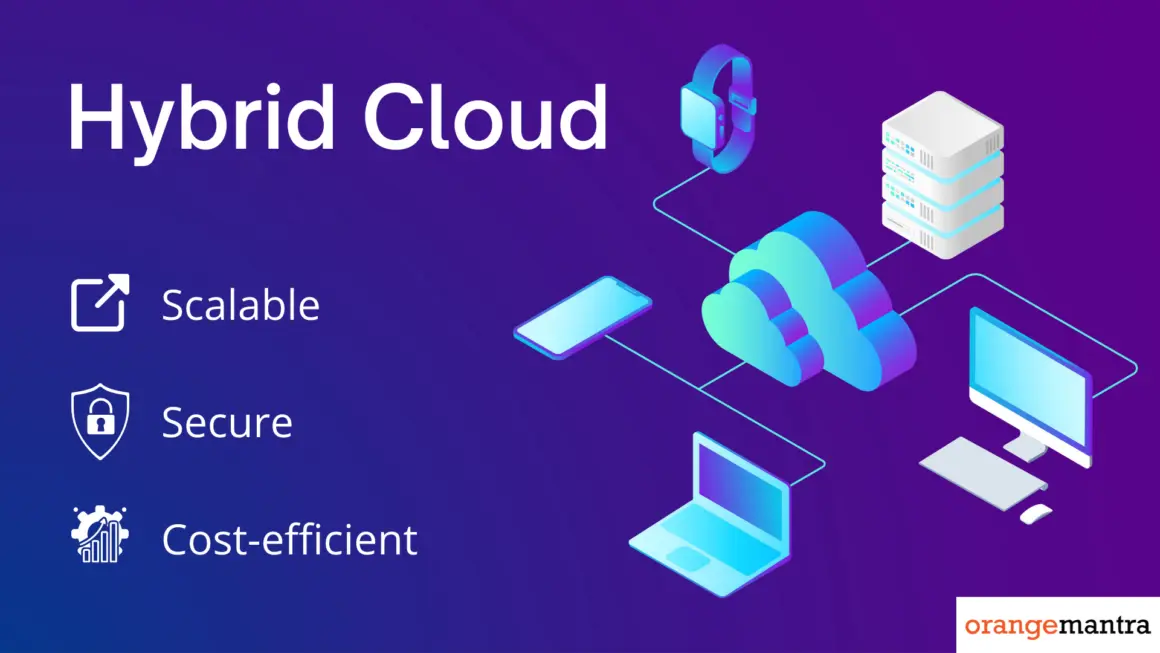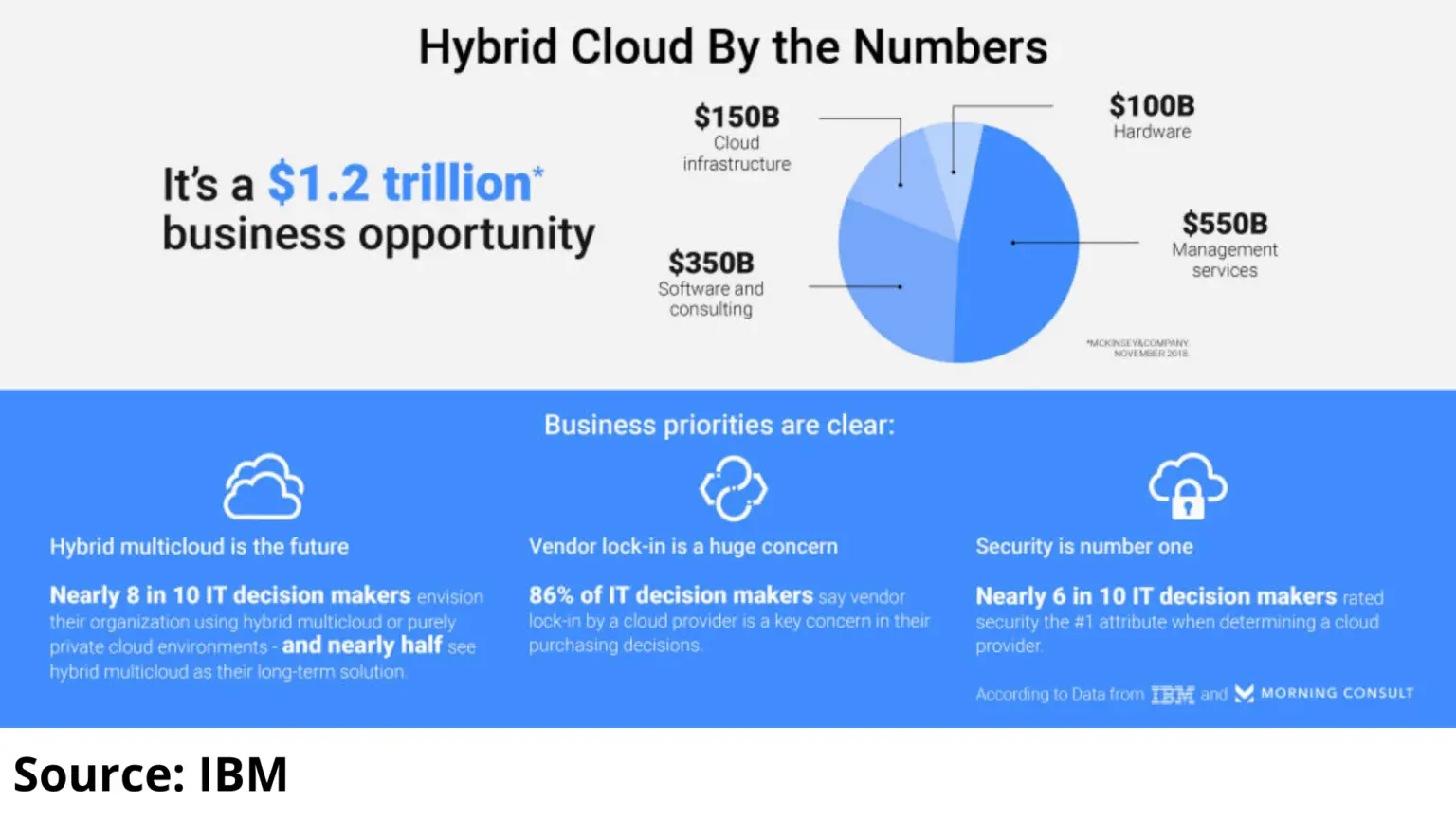With demands for scalability, flexibility, and disaster protection growing, more businesses are considering hybrid cloud adoption. As markets reopen in the West, tech executives are reviving their push to expand cloud-based enterprise capabilities. The global hybrid cloud market was valued at $85 billion USD in 2021, and by 2027, it is expected to reach $262 USD (Statista).
Hybrid cloud computing including the enterprise hybrid setup is emerging as a top choice among decision-makers in the IT space. Using this approach to cloud adoption, you could get more flexibility, lower costs, and bolster security. With enterprise technology solutions becoming more crucial to a company’s performance and competitiveness, leaders are eager to invest in infrastructure modernization. And this cloud model is the latest popular tool for accelerating digital transformation.
What is Enterprise Hybrid Cloud in Cloud Computing?
Fundamentally, an enterprise hybrid cloud shares the same concept as a hybrid cloud. It integrates on-premises infrastructure with both private and public cloud resources. This way, it facilitates seamless management, orchestration, and portability across these environments.
The integration allows for a unified and flexible IT ecosystem, enabling organisations to efficiently run processes, scale up traditional systems, and embrace cloud-native applications. The hybrid approach provides the agility to balance workload demands and optimise resources effectively.
Additionally, there is another way to understand an enterprise hybrid cloud as well.
You can consider it as a hybrid IT infrastructure representing a single IT ecosystem made up of system connections. These systems, which are tightly and seamlessly integrated through diverse networks like LANs, WANs, and VPNs, converge to create a cohesive infrastructure.
In essence, an enterprise hybrid cloud configuration encompasses several variations:
- Combination of Public and Private Clouds: At least one private and one public cloud working in tandem.
- Multiple Private Clouds: Integration of two or more private cloud environments
- Multiple Public Clouds: Utilisation of two or more distinct public cloud services
- Connection with Bare-Metal or Virtual Environments: Linking traditional infrastructure, either physical or virtual, to a public or private cloud
What defines this setup as a hybrid cloud is the seamless mobility of applications across these distinct yet interconnected environments. This fluidity allows applications to transition between various settings while maintaining connectivity. Crucially, a few of these environments must stem from consolidated IT resources capable of scaling as demand fluctuates.
Managing this amalgamated environment as a cohesive whole requires an integrated management and orchestration platform. This platform serves as the linchpin, enabling unified oversight and administration across the diverse components of the hybrid cloud infrastructure.
As you can see, there are quite a few similarities between hybrid cloud and enterprise hybrid cloud. However, there are certain differences as well.
Enterprise Hybrid Cloud vs Regular Hybrid Cloud
Since an enterprise hybrid cloud is a specific implementation of a hybrid cloud tailored for large-scale businesses or organisations, it differs in terms of scale, complexity, and purpose.
Scale and Complexity
Enterprise hybrid clouds are designed to handle huge chunks of data, applications, and users across multiple departments or locations within a large organisation. That’s the reason why they typically involve more complex architectures and integration with existing enterprise systems.
Customization and Control
Secondly, the greater the enterprise, the greater the level of customization and control requirements. Hence, enterprise hybrid clouds have specific configurations to meet stringent security, compliance, and governance requirements that aptly suit the organisation.
Resource Allocation
In an enterprise setting, resource allocation, especially in terms of computing power, storage, and network bandwidth, needs to be dynamically managed to support diverse workloads and departments.
An enterprise hybrid setup allows for the dynamic scaling of resources, allocating computing power and storage as needed across on-premises and cloud environments. This flexibility ensures optimal performance and cost efficiency for varying demands.
Integration with Legacy Systems
Enterprises often have very valuable legacy systems, i.e., older or outdated computing systems, software, applications, or technology that have been in use within an organisation for a considerably long period of time. This system needs to seamlessly integrate with the hybrid cloud environment, thus requiring specialised solutions and strategies.
Enterprise hybrid clouds enable modernization and interoperability through easy interaction with legacy systems, all without interfering with current workflows or jeopardising data security.
Service Level Agreements (SLAs) and Support
Enterprise hybrid clouds often demand more robust service level agreements and dedicated support to ensure high availability, reliability, and performance.
With the help of specialised assistance, organisations may adjust SLAs to the particular workload requirements of their hybrid infrastructure and preserve the dependability and responsiveness required for mission-critical applications.
All these advantages of enterprise hybrid cloud computing make it apt for large-scale businesses and make it a more sought-after option for businesses.
But before we move ahead, let’s get a quick comparison between public, private and hybrid clouds.
Private, Public and Hybrid clouds in Cloud Computing: What’s the same and what’s different?
Comparison Table between private, public, and hybrid cloud.
|
Aspect |
Public Cloud | Private Cloud |
Hybrid Cloud |
| Resource Pooling | Shares scalable resources among multiple tenants | Dedicated resources for a single user or group | Integrates resources across different environments |
| Cloud Computing | Enables running workloads within the system | Facilitates running workloads within the system | Allows running workloads across connected environments |
| Technology Mix | Utilises OS, management platforms, and APIs | Incorporates OS, management platforms, and APIs | Leverages diverse technologies across connected clouds |
| Integration | APIs, VPNs, LANs, WANs | Firewall-restricted access | Connected through LANs, WANs, VPNs, or APIs |
| Scalability | Scales on-demand using consolidated resources | Scalable, on-demand resources | Scales resources from connected environments |
| Management | Integrated management and orchestration platform | Single environment management | Managed as a single environment |
Similarities between Private, Public and Hybrid Cloud Computing
- Gathering, sharing, and managing computing resources through a network
- They can all run tasks and programmes within that specific cloud setup.
- Each kind of cloud, though, is put together using different technologies—usually involving an operating system, a management platform, and APIs.
- Some clouds also use virtualization and automation software to do even more.
Differences between Private, Public and Hybrid Cloud Computing
Now, here’s where things get interesting: before, you could easily tell public, private, and hybrid clouds apart based on where they were and who owned them.
But now, it’s not that straightforward anymore. So while we’ll compare the differences below, there are a lot of complexities to consider. To better understand, we can discuss these different clouds one at a time.
Let’s start with the public cloud.
Public Cloud
Any cloud is considered a public cloud when the environments are partitioned and redistributed to multiple users. In this set up, the infrastructure is not owned by the end user but instead by a large business offering cloud services such as Google Cloud Platform, Amazon Web Services (AWS), IBM Cloud, Microsoft Azure, etc.
Earlier, these clouds used to run completely off-premises. However, today, public cloud service providers have also started offering services in on-premise data centres for business users.
Private clouds
Private clouds are environments wherein the underlying IT infrastructure is dedicated to a single end user having complete and isolated access to the cloud.
Interestingly, private clouds no longer rely on an on-premise IT infrastructure. Businesses can build their private clouds on leased data centres that are distantly located and owned by a large cloud service provider.
Read more about the types of clouds in detail here – Cloud Hosting Solution Guide
Other types of clouds:
Managed Private Clouds
A private managed cloud is an environment exclusively dedicated to a user while externally managed by a third party.
In this setup, the infrastructure, including hardware, software, and resources, may be hosted on-premises or off-site in a data centre.
Dedicated clouds:
It’s like a cloud within a cloud—be it within a public cloud or a private one. For instance, an accounting department might have its own exclusive cloud space within the broader private cloud of an organisation.
Hybrid Multi-cloud
When you use more than one public cloud in your hybrid environment, it’s called hybrid multi-cloud. Hybrid multi-cloud systems could be both temporary and long-term.
For instance, an organisation could set up a hybrid multi-cloud environment to facilitate an application migration. However, multi-cloud increasingly represents the future of enterprise digital transformation, wherein flexibility and scalability reign supreme.
How Enterprise Hybrid Cloud Transform IT Businesses
The recent surge in digital transformation across industries has made it crucial for organisations to integrate hybrid clouds into their business operations. It not only facilitates better business operations but also secures your future with bolstered competitiveness.
But before you move forward with the integration, you should know that there are two types of hybrid cloud architecture:
- Traditional Hybrid Cloud Architecture
- Modern Hybrid Cloud Architecture
-
Traditional Hybrid Cloud Architecture
The traditional hybrid cloud architecture focused on transforming selected areas of a company’s on-premises system into private cloud infrastructure. It then connects the new infrastructure to public cloud environments such as AWS, Azure, and Google Cloud. Cloud computing solutions experts accomplished this using Red Hat OpenStack or enterprise-grade middleware to integrate cloud resources.
IT infrastructure that relies on this approach has better security and regulatory compliance. Such tech environments also exhibit superior scalability and resilience and enable organisations to adopt new technology dynamically. Besides, adopting a hybrid cloud also enhances your legacy applications and helps optimise resources.
-
Modern Hybrid Cloud Architecture
Unlike the traditional approach, modern architecture focuses more on enhancing the portability of applications across all cloud environments. Plus, cutting-edge hybrid cloud solutions automate the deployment of workloads to the most suitable cloud environments. Using this strategy for hybrid cloud modernization, you could significantly reduce overall IT spending while boosting agility. Also, it enables you to bolster competitiveness by creating such capabilities as advanced analytics.
An array of trends has accelerated the adoption of the hybrid cloud. A growing number of organisations are building new enterprise software applications as part of their ramped-up digital transformation plan. Many of them are replacing legacy systems with cloud-native solutions. Such a transition allows for seamless deployment, management, and performance across multiple cloud environments.
Besides, some businesses are moving their applications to the cloud to use micro-service architecture. It breaks software applications into smaller and loosely coupled components focused on specific functionalities. And IT infrastructure experts usually deploy these applications in lightweight executable units called containers.
Business Advantages of Hybrid Cloud
With technology becoming more critical to a company’s day-to-day operations and competitiveness, business leaders need to identify key areas of transformation. IT infrastructure modernization became the most urgent need for medium and large enterprises alike as the pandemic hit. Now, tech executives are considering the long-term benefits of hybrid cloud adoption.
-
Superior Speed
Cloud environments built on a hybrid model enable the IT staff of a company to optimise the network and minimise latency. Thus, it becomes easier for businesses to transfer data and migrate applications quickly. Besides, the hybrid could also take advantage of edge computing capabilities. It allows enterprises to boost speed and locate critical services closer to end-users.
-
Seamless Scalability
Scalability saw a meteoric rise in popularity last year as businesses scrambled to meet unprecedented demands. While a private cloud environment creates challenges to building a scalable infrastructure, the hybrid approach makes it smoother.
While there are obvious advantages to managing an on-premises system, it also creates roadblocks to agility. Using a hybrid cloud environment, you could continue to store critical data and operations in a private cloud. At the same time, you could also leverage the boundless capabilities of the public cloud.
-
Lower Costs
On the surface, hybrid cloud implementation might seem costlier. It surely has some additional costs. But, in the long run, it substantially reduces your overall IT costs. Unmatched scalability, seamless access, and robust security make migrating to a cloud environment an attractive alternative to a private cloud. Besides, by storing critical data and assets in a private cloud, you could avoid the potential costs of migrating systems from one vendor to another.
All these benefits open new windows of opportunity and boost your business. Let’s see what possibilities await you with enterprise hybrid cloud integration.
Opportunities with Enterprise Hybrid Cloud
Enterprise hybrid clouds make your IT business future-ready, agile, and cost-effective.
-
Flexible Solutions for Diverse Needs
An enterprise hybrid cloud introduces high-degree adaptability to your infrastructure strategy. This approach allows you to fine-tune resource allocation, seamlessly manage workloads between private and public clouds, and selectively utilise tools that are best suited for specific tasks.
It’s an agile and customised approach, optimising resources based on fluctuating demands and diverse operational requirements.
-
Robust security and uncompromising protection
Security is paramount in the digital landscape. A hybrid cloud offers protection on two levels. First, on the private level, the hybrid cloud model provides better data integrity by safeguarding sensitive information within a well-protected private cloud environment.
On the public level, it capitalises on the innovation and cost-effectiveness of public clouds. This dual-layered approach offers comprehensive protection without sacrificing accessibility, addressing regulatory compliance and data governance needs.
-
Agile Operations for Swift Adaptation
Rapid market shifts and changing demands require rapid adaptation. The hybrid cloud infuses your business with amazing agility through seamless integration of new services and exploration of cutting-edge technologies.
That too, without disrupting core operations, ensures stability while embracing innovation.
-
Efficiency Driving Cost Optimisation
Cost optimisation is the cornerstone of the hybrid cloud model. The flexible pay-as-you-go structure minimises unnecessary expenditures by dynamically scaling resources as needed.
This enhances cost-efficiency without compromising impressive performance or operational capabilities.
-
Future-Ready Infrastructure
The enterprise hybrid cloud is not merely a solution for today; it’s a strategic asset for future growth.
It fosters innovation, facilitates scalable growth opportunities, and positions your business at the forefront of its industry. Its adaptability ensures readiness for emerging technologies and market shifts, providing a competitive edge in an ever-evolving landscape.
Conclusion
Top decision-makers across industries are racing to translate their tech-driven strategies into accelerated business performance. And IT infrastructure modernization is critical to achieving this goal. Most tech executives believe that organisations cannot ensure agility simply by digitising processes. They need evolved cloud computing solutions that bolster competitiveness.
At OrangeMantra, a digital transformation solutions leader, we’re working on several cutting-edge cloud projects focused on next-gen enterprise capabilities. Over the past few years, our custom enterprise solutions have helped hundreds of clients take their businesses to new levels.
FAQs
Q. What are the business benefits of hybrid cloud computing?
Businesses can use these cloud environments to instantly scale capacity up or down per their requirements. It also enables you to avoid the time and cost of purchasing, installing, and maintaining new servers every time you want to expand your IT capabilities.
Q. Is there any security issue with hybrid cloud infrastructure?
Enterprises that use advanced cloud systems can use many of the same security measures that they use in their existing on-premises infrastructure. In fact, some businesses find such cloud solutions more secure than their on-premises data centres. These cloud ecosystems are always updated, have automated data redundancy, high availability, and disaster recovery capabilities, among other advantages.
Q. What is managed cloud hosting?
Managed cloud hosting is a process in which organisations share and access cloud-based resources. These include databases and software-tool applications spread across a remote network via multiple servers. Managed cloud hosting offers striking benefits like security and consistent availability.
























